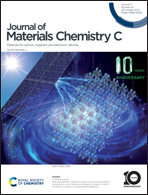Self-healing electrochromic energy storage devices based on PEDOT:PSS†
Abstract
Poly (3,4-ethylenedioxythiophene): poly (4-styrenesulfonic acid) (PEDOT:PSS) is a kind of widely used polymer with excellent electrical conductivity. In this study, PEDOT:PSS was modified to achieve self-healing ability while maintaining excellent energy storage properties. The modified PEDOT:PSS hybrid film demonstrated instantaneous self-healing ability due to physical cross-linking after being subjected to different external cuts (the average self-healing time was 1.44 s). When pressed at different rates, the film had a self-healing time of less than 0.12 s, and a retention rate of 74% after pressing 1750 times consecutively at a rate of 8.6 cm s−1. The mechanism of self-healing was investigated using theoretical calculations. Tungsten trioxide (WO3) was further introduced into the PEDOT:PSS hybrid film to fabricate electrochromic energy storage devices (EESDs), achieving a specific capacitance of 105.35 mF cm−2 and a capacitance retention of 98.2% after 1000 cycles. In the organic/inorganic hybrid system, the modified PEDOT:PSS film acted as both a protective coating for WO3 and exhibited a synergistic color change with WO3, ultimately improving the overall performance of the device. The present self-healing strategy can help design restorers for EESDs and can be extended to other new rechargeable electrochromic battery systems with good application prospects.



 Please wait while we load your content...
Please wait while we load your content...